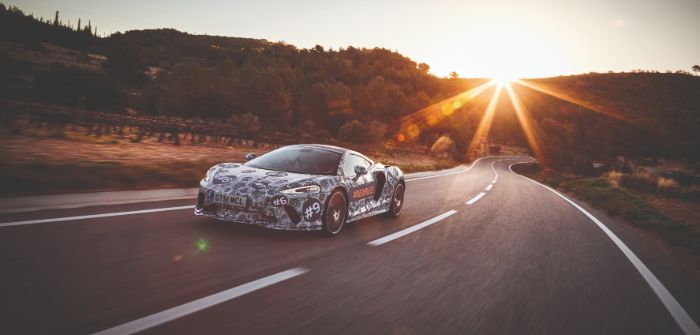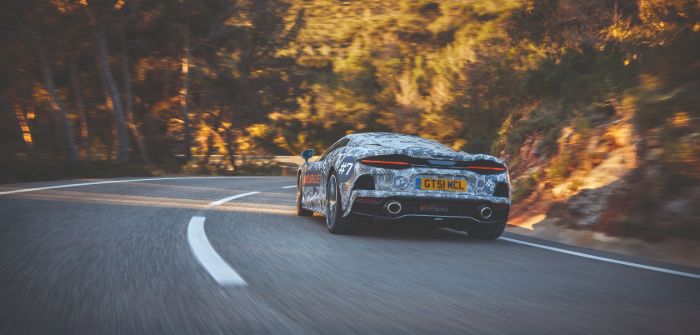Having embarked on an ambitious expansion program, McLaren is using motorsport technology to accelerate product development. Chief operating officer Dr Jens Ludmann is open-minded about what comes next.
While it’s not uncommon for car makers to point out engineering links between their motorsport programs and the contents of their showrooms, very few can claim a bloodline as direct as McLaren. Born out of a famed Formula 1 team in the 1980s, its engineering broke records with the F1 hypercar a decade later, before eventually launching as a standalone manufacturer within the McLaren Group in 2010, and evolution has come quickly since.
Today, the company has four model lines, an expanding global sales operation and two successful GT racing programs to its name. By 2025, it will have launched 18 new models within eight years, almost doubling its annual production to 6,000 vehicles, each hand-built at its factory in Woking, Surrey, UK. For Dr Jens Ludmann, who joined as COO with responsibility for engineering and technology three years ago, the opportunity to drive new, innovative technologies to market was too good to miss.
“I have the impression that whatever I did in the past was somehow pointing to this position,” he says. “I have a PhD in automotive engineering and worked in research, so I have always been at the leading edge of technology. Then I went to Ford, which is mass production, where I learned how effective processes and a structured organization operates, then boating, which is low volume production, luxury segment and fiberglass or composite materials. I’m also a hobby racer. The experiences I collected are now very useful in the role I play in McLaren.”
Ludmann’s position offers an unusually holistic view, from engineering through to production, with the flexibility to make changes as necessary. He’s introduced new quality and technology control methods as production has scaled up – from 3,300 units in 2017 to 4,800 in 2018 – and its R&D team has been restructured too. Engineers are split into two groups with cross-program responsibility, instead of working on individual products. One group manages product creation, the other addresses how to commercialize them.
“What’s unique here is the level of innovation that we’re ready to deliver and work on,” Ludmann says. “We have a mantra, ‘If something hasn’t been done before then that’s a reason to do it’. We like to innovate, we like to do things that haven’t been done before, and we like to be leading-edge in technologies, which is more risk-taking than you can do in other companies.
“If I reflect on my time at Ford… When we launched a product, the next day we built 1,800 cars per day. So, you cannot afford to take any risks or go with technology that is completely new. Here we can do that because we’re only building a handful of cars. We can manage this kind of technology, and we have gained enough experience from the prototype builds and the test phase to introduce it.”
Innovative partnerships
That ramping up of development is heavily supported by methods adopted from motorsport. New products are put through their paces on a Formula 1 derived simulator, reconfigured to offer 10 times more vertical motion to simulate ride quality on road surfaces, and the company has developed its own datalogging tools suitable for complex new vehicle systems. Prototype fleets are small but play a crucial role for checking proportions and in final validation, Ludmann says, adding that McLaren has increased its employee headcount to 150 at the Idiada test facility in Spain, expanding capabilities there in line with the product launch strategy.
In-house engineers are supported by close partnerships with suppliers, and McLaren encourages innovation by presenting awards to those who develop new solutions. The Senna, for example, features seats claimed to be the lightest in the industry, resulting from a collaboration with Italian manufacturer Sabelt. These weigh 8kg each when fitted, utilizing a double-skin carbon-fiber shell that’s one-third lighter than traditional production methods, and Alcantara or leather pads instead of foam.
It’s a mutually beneficial relationship: “We want to innovate with suppliers, not only to give us innovation that they see, but also when we have ideas we work with partners to develop them. We innovated the Senna seat concept and Sabelt helped us with the manufacturing process. Together, we came up with the lightest seat you could have in that segment, and we are happy for them to license that technology to other customers,” says Ludmann.
Volume changes aren’t the only challenge on the horizon. McLaren pioneered high-performance hybrid drivetrain technology with the P1 in 2013, and will use it range-wide by 2025, complemented by evolution of its combustion engines.
Driver experience
Ludmann sees electrification as a route to more aggressive power delivery, and the technology is advancing quickly. The 1,070ps drivetrain used in the Speedtail, a low-volume 250mph (400km/h) hypercar that completed its test program last December, features a new liquid-cooled inverter that offers twice the power output of the P1, but in a much smaller package. In the newly launched 765LT, meanwhile, the lithium-ion battery is 3kg lighter than its predecessor, the 720S, which debuted in 2017.
Further advances will continue to benefit from the wider McLaren Group’s R&D programs. McLaren Applied supplies battery packs to the entire Formula E grid, some of which also use power-dense motors based on technology from the P1, and the company is working on a new generation of lightweight, ultra-fast-charging batteries for electric cars. The target is at least 30 minutes of track time on a single charge.
Ludmann says the company is open-minded about the future: “In our cars, lap time and the power-to-weight ratio is key. So, if an electric car gives you better lap time than a combustion engine car, then the driver experience is superior. If we can do a car like that, then we feel that this inherits the McLaren DNA,” he says.
“Whenever we do electrified vehicles, either hybrid or full electric, they will be lighter than any competitor. Our focus is on the driver and the driver experience. Lighter cars will handle much better, and that’s a key differentiation.”
The result of adding heavy hybrid components is an even greater focus on offsetting that weight elsewhere. Carbon fiber has been a core technology for McLaren since it was used by the Formula 1 team almost 40 years ago, and is now used in the chassis tubs of all new models. A bespoke £50m (US$65m) site near Sheffield, UK, McLaren’s second-ever factory, opened in 2018 with responsibility for developing and manufacturing carbon-fiber and composite parts. It’s a recognition that this can support efficiency and performance improvements for forthcoming powertrains.
Ludmann sees McLaren’s opportunities and challenges as unique. “We are, thankfully, in a niche segment, which has a defined and stable customer base,” he says. “So we don’t expect to be hit by connectivity, autonomy and electrification too much. Everything we do targets driver betterment and we consider those technology trends in terms of how we can translate them into the driving experience.” It helps, he says, that the company has the right talent in place to maintain that focus on performance.
“The McLaren brand attracts very good, talented, innovative people who continue to push boundaries, and it’s exciting to work with them. So, we have access to the race technology, and we have people that love to innovate. Some come from racing, some come from other areas, and combining that, we’re never short of ideas for new products.”
Space race
When McLaren took its hyper-GT to the Johnny Bohmer Proving Grounds at the Kennedy Space Center for high-speed validation tests, those in the know were expecting it to be fast, but not many were expecting it to hit its 403km/h (250mph) top speed more than 30 times.
The reality is that the Speedtail is McLaren’s fastest car yet. And to reach these heights, engineers at the Woking-based OEM plucked technology after technology from its motorsport roots.
Ensuring low vehicle weight as well as aerodynamic excellence was a vital development focus, but fundamental to the hybrid hyper-GT’s performance is its race-bred electric drive system. Engineers from McLaren Applied worked with the Speedtail Electric Drive Technology team to integrate its inverter and DC/DC converter tech, and allow the levels of control and power management required.
The 1.647kWh high-voltage energy storage system, meanwhile, looks to offer game-changing power-to-weight ratio. Arranged in a unique array, the cylindrical cells generate 270kW peak output and 5.2kW/kg power density.
Intelligent thermal management allows the Speedtail to hit its top speed over and over. The cells use a dielectric cooling system and are immersed in an electrically insulating oil which transfers heat away. This allows the cells to run harder and for longer.
The track as a lab
Although McLaren is perhaps best known for its Formula 1 programs, its automotive division has become
a force to be reckoned with in GT racing. Vehicle development is carried out in full by an in-house department, launched in 2011, which has supplied cars to teams competing in GT3 and GT4 race classes all over the world.
This process relies on close links to central engineering, underpinning ongoing evolution of road and racing cars. The GT cars are derived from a production chassis and drivetrain, and offer extreme case testing of efficiency, reliability and serviceability that can be shared between departments. In turn, this helps tailor chassis engineering for more predictable road manners, while also reducing the running costs of the car.
In 2018, that pool of information was broadened with the launch of the Pure McLaren GT Series. Designed as an arrive-and-drive event for experienced track drivers looking to step up into professional racing, this uses a fleet of mechanically identical 570S GT4 cars. Logistics and maintenance are managed by McLaren between races, and events offer a chance to liaise with drivers and inform future vehicle development.
“As we’re close to the customers, we get very clear feedback about the expectations of our products and what they’re excited about, so that’s the first strong piece we get,” explains Ludmann. “The second is we test race technologies on those cars and get first-hand feedback. On one of our events in Bahrain last year we rolled out the Senna GTR to some customers who are racing in the GT4 class. So it’s closely linked, we get a lot of experience from that.”
By Alex Grant




